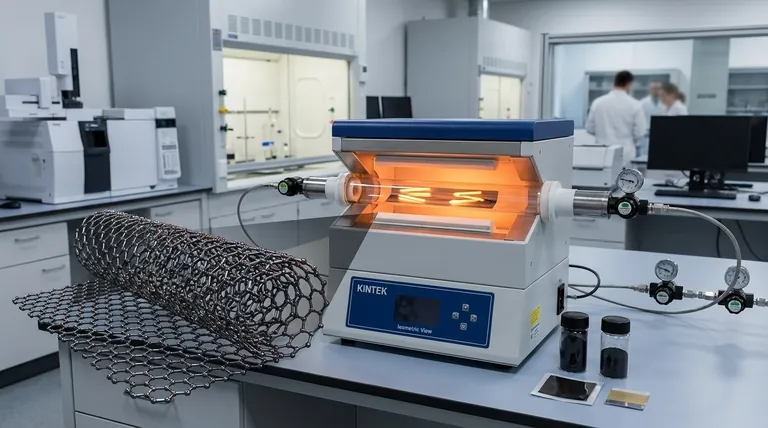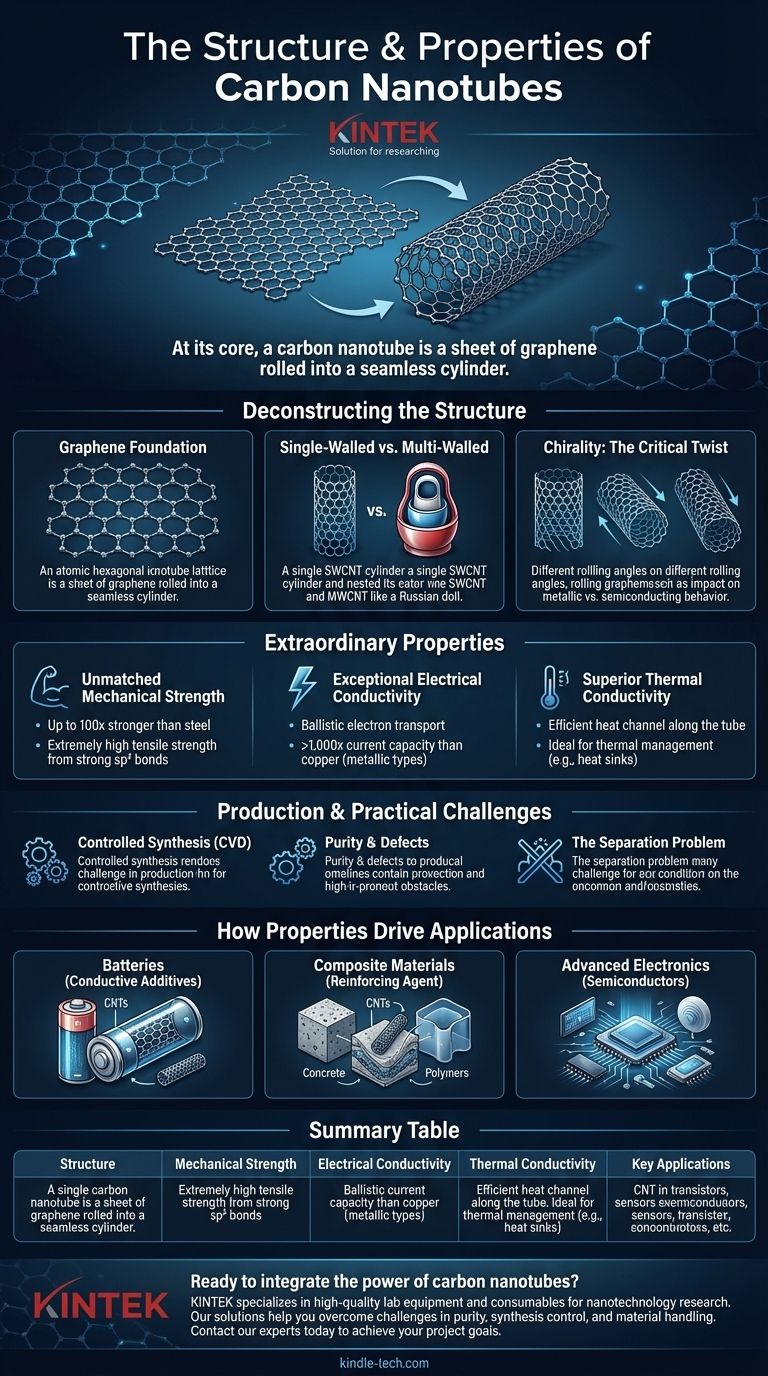At its core, a carbon nanotube is a sheet of graphene rolled into a seamless cylinder. This unique, one-dimensional structure gives rise to a remarkable combination of properties, including exceptionally high mechanical strength, and electrical and thermal conductivity that far exceed most conventional materials.
The true power of a carbon nanotube lies in its geometry. How a single sheet of carbon atoms is rolled determines everything—whether it behaves like a metal or a semiconductor, its ultimate strength, and its potential to revolutionize industries from electronics to materials science.

Deconstructing the Nanotube Structure
Carbon nanotubes (CNTs) are allotropes of carbon, belonging to the same family as diamond and graphite. Their structure is their defining feature.
The Graphene Foundation
The starting point for any CNT is graphene, a single, one-atom-thick sheet of carbon atoms arranged in a hexagonal lattice. Imagine a sheet of chicken wire, but at the atomic scale.
Single-Walled vs. Multi-Walled
CNTs come in two primary forms. Single-walled carbon nanotubes (SWCNTs) consist of a single cylinder of graphene. Multi-walled carbon nanotubes (MWCNTs) are made of several concentric cylinders of graphene nested within each other, like a Russian doll.
Chirality: The Critical Twist
The way the graphene sheet is "rolled" is defined by its chirality, or the angle of its atomic lattice relative to the tube's axis. This single geometric factor is critically important.
Chirality dictates whether a nanotube is metallic or semiconducting, a fundamental distinction for any electronic application.
The Extraordinary Properties Explained
The unique cylindrical structure and strong atomic bonds of CNTs give them a set of unparalleled material properties.
Unmatched Mechanical Strength
The carbon-carbon bonds (sp²) in a CNT are among the strongest chemical bonds in nature. This gives nanotubes an extremely high tensile strength—reportedly up to 100 times stronger than steel at a fraction of the weight.
Exceptional Electrical Conductivity
Due to their structure, electrons can travel through certain types of CNTs with very little resistance, a phenomenon known as ballistic transport. Metallic nanotubes have an electrical current capacity more than 1,000 times greater than copper.
Superior Thermal Conductivity
CNTs are also excellent thermal conductors, efficiently channeling heat along the length of the tube. This makes them ideal for applications requiring thermal management, such as heat sinks for electronics.
Production and Practical Challenges
While their properties are impressive, producing and working with CNTs presents significant technical hurdles.
The Challenge of Controlled Synthesis
The dominant commercial production method is chemical vapor deposition (CVD). However, precisely controlling the synthesis to produce nanotubes with a specific chirality and length at scale remains a major challenge.
Factors like temperature and carbon source concentration must be meticulously controlled to influence the final product.
Purity and Defects
Real-world nanotubes often have atomic defects or impurities, such as amorphous carbon. These imperfections can dramatically degrade their mechanical and electrical properties, creating a gap between theoretical potential and practical performance.
The Separation Problem
A typical synthesis process produces a mix of metallic and semiconducting nanotubes. For high-end electronics, these must be separated—a complex and costly process that has slowed their adoption in applications like computer chips.
How These Properties Drive Applications
The unique combination of properties makes CNTs a transformative additive material in numerous fields.
Conductive Additives in Batteries
The high electrical conductivity of CNTs makes them a superior additive in lithium-ion batteries. They create a highly effective conductive network within the cathode and anode, improving charge rates and overall battery life.
Reinforcing Composite Materials
The immense strength of CNTs allows them to be used as a reinforcing agent. Even small amounts added to polymers, concrete, or metals can significantly enhance the strength and durability of the final composite material.
Advanced Electronics and Sensors
The semiconducting properties of specific CNTs make them candidates for next-generation transistors and sensors. Their small size and excellent electronic properties are also leveraged in transparent conductive films for displays and solar cells.
Making the Right Choice for Your Goal
Selecting the right type of nanotube is entirely dependent on the desired outcome of your application.
- If your primary focus is electrical conductivity: You need high-purity metallic nanotubes, likely SWCNTs, for applications like battery additives or transparent films.
- If your primary focus is mechanical reinforcement: Cost-effective MWCNTs are often the best choice, as their bulk strength is the most important factor for composites.
- If your primary focus is advanced electronics: You require precisely separated, high-purity semiconducting SWCNTs, which represents the most challenging and expensive application.
Ultimately, understanding the direct link between a carbon nanotube's atomic structure and its material properties is the key to unlocking its vast potential.
Summary Table:
| Property | Description |
|---|---|
| Structure | Cylindrical tubes of rolled graphene sheets (SWCNTs or MWCNTs). |
| Mechanical Strength | Extremely high tensile strength, up to 100x stronger than steel. |
| Electrical Conductivity | Can be metallic or semiconducting; supports ballistic electron transport. |
| Thermal Conductivity | Excellent thermal conductors, ideal for heat management. |
| Key Applications | Battery additives, composite reinforcement, advanced electronics, and sensors. |
Ready to integrate the power of carbon nanotubes into your research or product development?
KINTEK specializes in providing high-quality lab equipment and consumables for nanotechnology research. Whether you are synthesizing, characterizing, or applying CNTs, we have the tools and expertise to support your work. Our solutions help you overcome challenges in purity, synthesis control, and material handling.
Contact our experts today to discuss how we can help you achieve your project goals with precision and reliability.
Visual Guide

Related Products
- Customer Made Versatile CVD Tube Furnace Chemical Vapor Deposition Chamber System Equipment
- Graphite Vacuum Continuous Graphitization Furnace
- Vacuum Heat Treat Furnace with Ceramic Fiber Liner
- Ultra-High Temperature Graphite Vacuum Graphitization Furnace
- Vertical Laboratory Tube Furnace
People Also Ask
- What are nanotubes drawbacks? The 4 Major Hurdles Limiting Their Real-World Use
- What are the challenges of carbon nanotubes? Overcoming Production and Integration Hurdles
- How do nanotubes affect the environment? Balancing Low Carbon Footprint with Ecological Risks
- What is the floating catalyst method? A Guide to High-Yield CNT Production
- Why are carbon nanotubes important in industry? Unlocking Next-Generation Material Performance



















